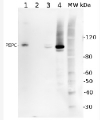1

PEPC | Phosphoenolpyruvate carboxylase positive control/quantitation standard
AS09 458S | Protein standard for quantitation and positive control
50% discount until June 30
Use promotional code: Stand50
- Product Info
-
Format: Lyophilized in glycerol. Quantity: 100 µl Reconstitution: For reconstitution add 60 µl of steril water, Please notice that this product contains 10% glycerol and might appear as liquid but is provided lyophilized Storage: Store lyophilized/reconstituted at -20°C; once reconstituted make aliquots to avoid repeated freeze-thaw cycles. Please remember to spin the tubes briefly prior to opening them to avoid any losses that might occur from material adhering to the cap or sides of the tube. Tested applications: Western blot (WB) Recommended dilution: Standard curve: 3 loads are recommended (0.5, 2 and 4 μl).
For most applications a sample load of 0.2 μg of chlorophyll/well will give a RbcL signal in this range.Positive control: a 2 μl load per well is optimal for most chemiluminescent detection systems. Higher standard concentration needs to be used to allow detection by Coomasie stains. Such gels with higher standard concentration can not be used for quantitation using chemiluminescence.
This standard is stabilized and ready and does not require heating before loading on the gel.
Please note that this product contains 10% glycerol and might appear as liquid but is provided lyophilized. Allow the product several minutes to solubilize after adding water. Mix thoroughly but gently Take extra care to mix thoroughly before each use, as the proteins tend to settle with the more dense layer after freezing.Expected | apparent MW: 110 | 105 kDa
- Application Examples
-
Application example 
5 ug total protein from 10-day old Zea mays leaves was loaded into Bolt 4-12% Bis-Tris Plus polyacrylamide gel (Invitrogen) in NuPAGE LDS sample buffer (1X, Invitrogen) and dithiothreitol (50 mM) along with four concentrations of PEPC standard (100, 200, 400 and 800 fmoles). The same concentrations of standard from lyophilized sample were also loaded into the same gel to evaluate the effectiveness of lyophilization process. Proteins were separated in Bolt MOPS SDS running buffer (1X, Invitrogen) at 200 V for 32 min using a Bolt Mini Gel Tank (Invitrogen). Proteins were then transferred onto 0.2-μm polyvinylidene fluoride membranes (PVDF, Immobilon) for 80 min at 20 V in NuPAGE transfer buffer (1X, Invitrogen) containing methanol (10%, v/v) and Bolt Antioxidant (Invitrogen) using Bolt Mini Blot Module (Invitrogen). Following the transfer, membrane was blocked for 1 h in 2% (w/v) membrane blocking agent dissolved in Tris-buffered saline solution containing Tween-20 (TBS-T; Tris, 20 mM; NaCl, 137 mM; Tween-20, 0.1% v/v). The membrane was treated with PEPC antibody (1:10,000, w/v in blocking solution, AS09 458) for 1h. Membrane was washed with TBS-T twice briefly, then once for 15 min and three times for 5 min each. Membrane was then incubated for 1 h with a horseradish peroxidase-conjugated goat anti-rabbit antibody (Agrisera; 1:25 000, w/v in blocking solution, AS09 602) followed by washing as described above. The signals were detected using ECL reagent and visualized using the Molecular Imager VersaDoc MP 4000 System (Bio-Rad). - Additional Information
-
Additional information: The PEPC protein standard can be used in a combination with Agrisera global PEPC antibiody to quantitate PEPC from a wide range of species. Global antibodies are raised against highly conserved amino acid sequence.
Quantitative western blot: detailed method description, video tutorial
Additional information (application): Concentration: after re-constitution with sterile milliQ water final concentration of the standard is 0.15 pmoles/µl
Protein standard buffer composition: Glycerol 10%, Tris Base 141 mM, Tris HCl 106 mM, LDS 2%, EDTA 0.51 mM, SERVA® Blue G250 0.22 mM, Phenol Red 0.175 mM, pH 8.5, 0.1 mg/ml PefaBloc protease inhibitor (Roche), 50 mM DTT.
This standard is ready-to-load and does not require any additions or heating.
This standard is stabilized and ready and does not require heating before loading on the gel.
Please note that this product contains 10% glycerol and might appear as liquid but is provided lyophilized. Allow the product several minutes to solubilize after adding water. Mix thoroughly but gently Take extra care to mix thoroughly before each use, as the proteins tend to settle with the more dense layer after freezing. - Background
-
Background: Phosphoenolpyruvate carboxylase (PEPC; EC 4.1.1.31) serves as an important control element in the regulation of photosynthetic carbon metabolism in C4 and CAM plants. This is the first enzyme of the pathway, and PEPC enzymes are encoded by a small multigenic family. Several isoforms of PEPC have been characterised in maize, sorghum and sugarcane. These isoforms are involved in several functions such as the initial fixation of atmospheric CO2 (= C4 PEPC) and anaplerotic functions associated with nitrogen assimilation or amino acid biosynthesis (Lepiniec et al. 1994). - Protocols
-
Agrisera Western Blot protocol and video tutorials
Protocols to work with plant and algal protein extracts
Oxygenic photosynthesis poster by prof. Govindjee and Dr. Shevela
Z-scheme of photosynthetic electron transport by prof. Govindjee and Dr. Björn and Dr. Shevela - Reviews:
-
This product doesn't have any reviews.
Accessories

AS09 458 | Clonality: Polyclonal | Host: Rabbit | Reactivity: A. comosus, A. thaliana, C. ciliaris, C. gayana, C. velia, Ch. quinoa, H. vulgare, J. curcas, K. prostrata, L. fusca, Lupinus sp. , M. maximus, M. crystallinum, N. tabacum, O. sativa, P. antidotale, P. coloratum, P. strobus, Saccharum spp. hybrid clone C91-301, S. lanata, S. laricifolia, S. bicolor, Synechocystis PCC 6803, Phaeodactylum tricornutum (strain CCAP 1055/1), T. weissfloggi, Z. mays, Z. muelleri
Benefits of using this antibody
50% discount on matching standard/positive control
AS09 458S PEPC | Phosphoenolpyruvate carboxylase positive control/quantitation standard
Use promotional code: Stand50

AS09 458-HRP | Clonality: Polyclonal | Host: Rabbit | Reactivity:A. comosus, A. thaliana, S. PCC 6803, Ch. velia, H. vulgare, J. curcas, Lupinus sp. , M. crystallinum, N. tabacum, O. sativa, Saccharum spp. hybrid clone C91-301, S. laricifolia, Z. mays, Synechocystis sp. , P. tricornutum (strain CCAP 1055/1), T. weissfloggi
Benefits of using this antibody

